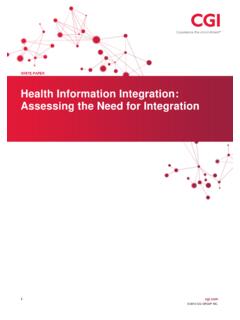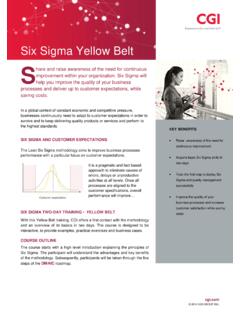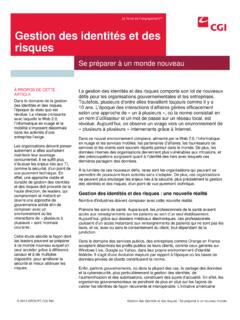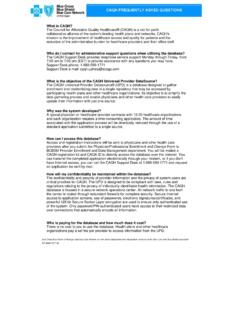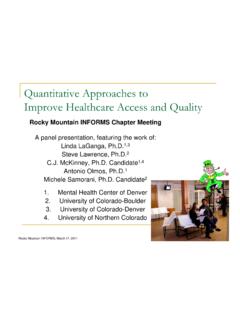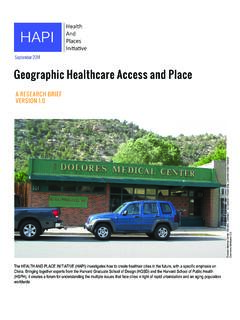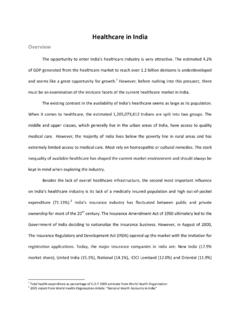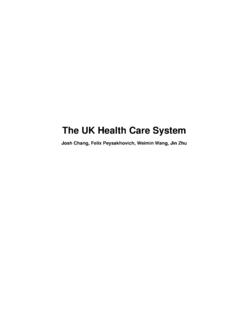Transcription of Healthcare Challenges and Trends - cgi.com
1 WHITE PAPER. Healthcare Challenges and Trends The Patient at the Heart of Care quality Healthcare is one of the most important factors in how individuals perceive their quality of life. In most countries, alongside the economy, it is the major political issue. In some countries, the Healthcare delivery organization is a part of the national identity. CGI believes it is time for a new enlightenment in every aspect of the Healthcare ecosystem, where every player, from governments to enterprises to individuals, is involved in improving Healthcare . This is part of a series of white papers on key aspects affecting the move toward an Enlightened Healthcare Ecosystem. The other two papers focus on the Convergence of Health and Pharma and the need for Innovation in Health IT. 1 2014 CGI GROUP INC. GLOBAL Challenges .
2 Globally, all health economies are facing similar Challenges . The advent of new consumer technology is introducing even more Challenges , or bringing older ones to the fore. This disruptive technology promotes greater patient power. The most agile and forward-thinking health economies have the opportunity to revolutionize the way care is delivered, and in doing so, to transform their societies. This paper outlines Challenges with which we see our clients struggling, and some of the Trends we think will impact Healthcare for the better. Among the global Challenges that will impact Healthcare in the near future are: Rising costs FIGURE 1: HEALTH EXPENDITURE AS A SHARE OF GDP, 1960- Spending on Healthcare almost invariably grows faster than GDP. 2009, SELECTED OECD COUNTRIES. The rate of growth of Healthcare spend has exceeded that of GDP Source: OECD Health Data since records began.
3 Moreover, spending and economic recession are closely linked. We can expect to see the rate of growth of Healthcare spend in Europe outstrip GDP growth significantly during the current economically difficult times. Macroeconomic factors like aging populations or insufficient public funding are challenging both receivers and providers of Healthcare . Adoption and penetration rates of clinical information systems vary greatly. In fact, the number (and size) of buyers varies from country to country, and is not necessarily dependent on the size of the country but rather on the structure of the Healthcare system. Additionally, purchasing behavior is shifting towards more coordinated, joint purchasing. Changing demographics Service is in demand There is increasing demand on the Healthcare delivery organizations, and this is happening in every country.
4 People live longer thanks to advances in understanding of the causes of diseases, and consequent improvements in diagnostic techniques and treatments. The average life expectancy in OECD countries has now reached 80 years and continues to lengthen. However, not only are people living longer, but increasingly people are living longer with chronic disease. FIGURE 2: LIFE EXPECTANCY AT BIRTH, 2009 (OR NEAREST YEAR), AND YEARS GAINED. SINCE 1960 - Source: OECD Health Data 2. Filling the resource gap FIGURE 3: MEDICAL GRADUATES PER 1,000. PHYSICIANS, 2009 (OR NEAREST YEAR). Even as demand increases, there is a global shortage of clinicians. Source: OECD Health Data Countries with the highest number of clinicians per population will need to address graduate intake in to medical schools, which is falling in real terms in many countries.
5 As demand and The challenge is not limited to doctors either, as enrollment in nursing colleges has also fallen in some countries. spending increase, Arguably, a storm is brewing in France, where the number of doctors over 55 is among health economies the highest in the OECD. Combined with an overall reduction in the number of graduates emerging from medical school, France may well see the number of doctors increasingly will leaving the profession exceeding those entering it. It is generally the case that a skills need to balance shortage increases costs (or reduces service quality ), so a well-run health system makes sure staff are properly equipped and doing the right tasks for their skills and ease of access to training. This presents an ethical challenge as some countries seek to fill the gap by their services recruiting doctors and nurses from other countries, thus depriving those societies of their Healthcare professionals.
6 Against the cost of operating smaller Easy access hospitals. The graph below shows the distribution of hospital sizes. As demand and spending increase, health economies increasingly will need to balance ease of access to their services against the cost of operating smaller hospitals. For many countries, the rationalization of the Healthcare system means the closure of small regional hospitals, which becomes a politically-charged issue. This rationalization also has to take into account the increasing specialization of tertiary hospitals, which is discussed later in this paper. FIGURE 4: SHARE OF HOSPITALS BY NUMBER OF BEDS. Source: Nordic Healthcare Group 3. Focus on quality What patients expect is changing The quality of care is increasingly important as patients begin to exercise their right to choose how and with whom they engage for their Healthcare .
7 They demand transparency of data and To address the processes. As a consequence, Healthcare organizations will need to focus on how quality needs of the expert outcomes can be published in a meaningful way for patients. Patient safety is the major focus of patient advocacy groups and Healthcare leaders. They will enforce deeper investigations of patient, and to start medication errors, hospital acquired infections, wrong site surgery or pressure sores, like never the transition of before. Becoming customer-driven Healthcare to a Where the patient needs to be at the heart of care demand-driven To address the needs of the expert patient, and to start the transition of Healthcare to a demand- model, some of the driven model, some of the world's leading hospitals are placing the patient firmly at the center of everything they do.
8 For example, the Cleveland Clinic in Ohio has a clear mission to improve the world's leading patient experience, and has a board-level Chief Experience Officer leading the Office of the hospitals are placing Patient Experience. According to their website, the mission is to ensure care is consistently patient-centered by partnering with caregivers to exceed the expectations of patients and their the patient firmly at families. Cleveland Clinic, along with a handful of other pioneering hospitals, has always been a the center of bellwether in patient care, and it will be interesting to see how many other hospitals make similar arrangements. everything they do. GLOBAL Healthcare Trends . Move from being supply driven towards a demand driven consumer model As a society, we are changing rapidly, and this is apparent in the relationship between care providers and the citizen.
9 Patients are increasingly becoming stakeholders in their own care journeys; they demand transparency in access and information about their care and importantly, about the quality of service provided. Citizens are now demanding access on their terms. They want to schedule appointments when and where it suits them, not the provider. They want the latest drugs or clinical trials; and of course, an end to surgical waiting lists. Or they want to be given the option to go private' without incurring a personal cost. The Internet is changing citizen behavior. This means the way governments interact with their citizens has to change too. Municipalities are providing more services to the citizen using technology. We will see Healthcare providers do the same adopt technological solutions to streamline processes such as setting up virtual appointments with doctors or looking up lab results online.
10 Healthcare is the last of the major supply driven industries. It will not be so for long. It will be the citizen that demands the transition to an industry that answers their needs, fears and aspirations. Informed patients and the rise of social media Patients are becoming more and more involved in their Healthcare , with a higher stake in the journey than before. Patients are simply better informed than ever before. Information about medical conditions and treatments are now easily available on the Internet. This has to some extent, shifted the focus of the patient-provider relationship towards the patient. The advent of social media is also driving Healthcare interactions in new ways. Patients are exploiting these resources to discuss treatments, procedures and even individual practitioners. Alongside, Healthcare practitioners, agencies and charities too will need to use social media to communicate with their citizens; in times of crisis this will become a critical mechanism.


